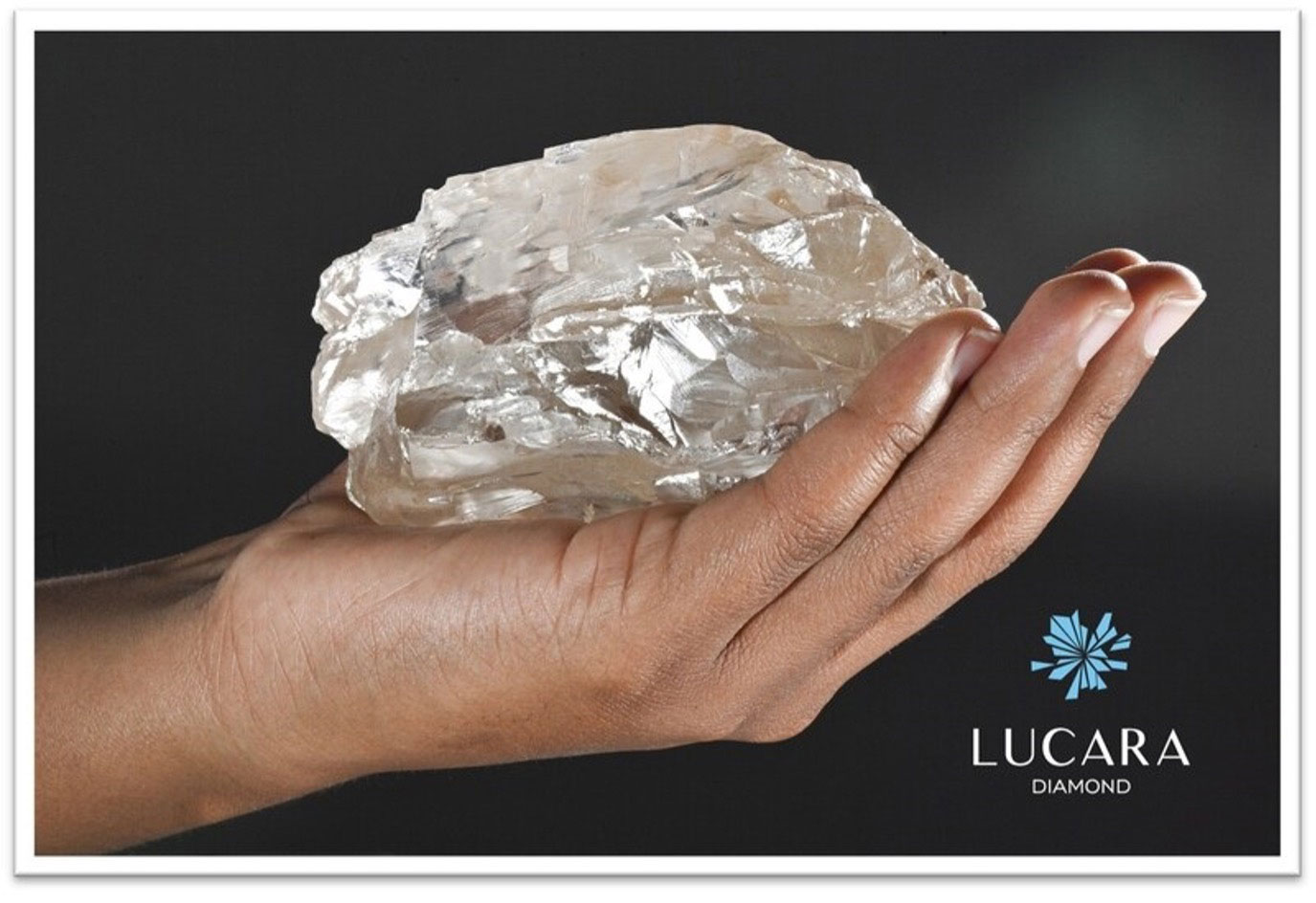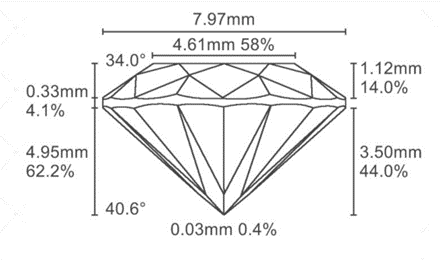BIG diamonds

Photo: CNW Group/Lucara Diamond Corp
A diamond weighing a whopping 2,492 carats was recently recovered from a Botswana mine. Since a deposit of even 100 carats is considered important, this was a historic event.
The company's CEO was jubilant, remarking that no one in living memory had ever held a diamond of this size.
Of course this find was not "a diamond," as we lay people think of a diamond. It is a remarkably large piece of diamond material, diamond rough, from which an unknown number of large gems, as well as many smaller ones, will be cut, faceted, and most probably set in jewelry.
About the rough
Deposits of diamond are limited. Some diamond mines have already been depleted, while others hold only smaller deposits that can yield only smaller gemstones. Some larger diamonds found in older jewelry would be impossible to replicate today. The rarity of large deposits is a major reason the price-per-carat is dramatically higher for large diamonds than for smaller ones.
Diamond deposits that remain are harder to locate, and they are increasingly difficult and expensive to access. Lacara, the company that retrieved the huge stone shown above, was able to locate it because of new, multi-million-dollar XRT technology—Mega Diamond Recovery X-ray Transmission, to give its official name. The technology allowed the company to precisely locate and identify the massive diamond deposit and to remove it intact.
From rough to gems
Sources have put the stone's value at $40 million to $60 million, though the stone's quality has not yet been established. The rough will be carefully examined to determine how it should be cut to yield the most beautiful, and valuable, faceted gems.
This stone is being compared to the Cullinan diamond, found in South Africa in 1905, which weighed in at 3,106 carats. Cutting the Cullinan was a major event. Experts took three months just to decide how to cut it, what shapes to give the finished gems in order to maximize yield from the rough.
Eventually, the Cullinan yielded 9 major stones, 96 brilliant cut diamonds, and 9.50 carats of unpolished pieces. The total weight of the cut stones was 1,065 carats, representing a 65% weight loss in cutting. A large loss of material is inevitable in cutting rough in order to produce well- proportioned gems of highest beauty.
The largest stone cut from the Cullinan, a 530.20-carat diamond known as the Star of Africa, was set into the British royal scepter. The other gems from the Cullinan eventually became part of other jewelry belonging to the royal family.
Importance of Cut proportions
Though it's unlikely that diamonds from this huge piece of rough will cross your desk, you may well have insureds seeking coverage on diamonds of significant size and relatively high valuation. Be aware that of the 4 Cs—Cut, Color, Clarity and Carat weight—Cut usually has more influence than size on valuation.
A gem's Cut refers not to its shape but to its geometric proportions. In the world of retail jewelry, many diamonds are deliberately cut to produce bigger stones, because carat weight is often the only factor that consumers understand. But bigger is not necessarily better. A poorly proportioned diamond will not show the gem to best advantage.
For a diamond in its setting, light enters from the top of the stone and is funneled downward where it strikes facets at the bottom, then is refracted to other facets of the stone again and again as it works its way back up, until it leaves the stone at the top and enters the eye of the observer. Cutting proportions are extremely precise to achieve the best effect.
Read more about the importance of cut quality in determining the value and beauty of all diamonds.
FOR AGENTS & UNDERWRITERS
An appraisal for any scheduled diamond jewelry should specify the color, clarity, carat weight and cut of the gem.
The most reliable appraisal is written by a qualified gemologist (GG, FGA+, or equivalent), preferably one who has additional insurance appraisal training.
 All scheduled diamond jewelry should have a grading report from a reliable gem-grading lab.
All scheduled diamond jewelry should have a grading report from a reliable gem-grading lab.
The report will include cut information, perhaps as a diagram something like the one at right, which is from a GCAL report. If there is not such a diagram, look for the terms table, crown, crown angle, girdle, pavilion, and culet.
These are the most reputable gem-grading labs, and you can use the links to verify reports you receive:
Gemological Institute of America GIA Report Check
American Gem Society Lab AGS Report Verification
Gem Certification and Assurance Lab Verify Your GCAL Certificate
Your files should include a copy of the report, not just the appraisal referencing the report number.
Be alert to the possibility of a lab-made diamond being passed as a mined diamond. The appraisal and lab report should clearly state whether the gem is mined or lab-grown. Mined diamonds have a far higher value than lab-grown ones.
FOR ADJUSTERS
On a damage claim, ALWAYS have the jewelry examined in a gem lab that has reasonable equipment for the job and is operated by a trained gemologist (GG, FGA+ or equivalent), preferably one who has additional insurance appraisal training, such as a Certified Insurance Appraiser™.
In reviewing the appraisal, be on the lookout for "approximate" weights. This term indicates that the appraiser examined the stone in its setting and could not weigh it alone. The appraiser took measurements and put them through a mathematical formula that approximates weight.
An approximate weight leaves wiggle room for the replacing jeweler. He may go down a couple of points, suggesting that it is still close to the weight of the original. A few points difference in weight can mean a significant difference in the price for you.
A piece of jewelry may contain a lot of small diamonds, perhaps a couple dozen 1- or 2-point diamonds. And they may be of poor quality (often appraisals do not even mention the quality of very small diamonds). It's easy for an unscrupulous jeweler to take advantage of the word "diamond" attached to those tiny gems and overcharge you for these inexpensive commodities. Work with a jeweler you can trust or with an insurance gem lab providing specialized services to adjusters.
©2000-2025, JCRS Inland Marine Solutions, Inc. All Rights Reserved. www.jcrs.com



